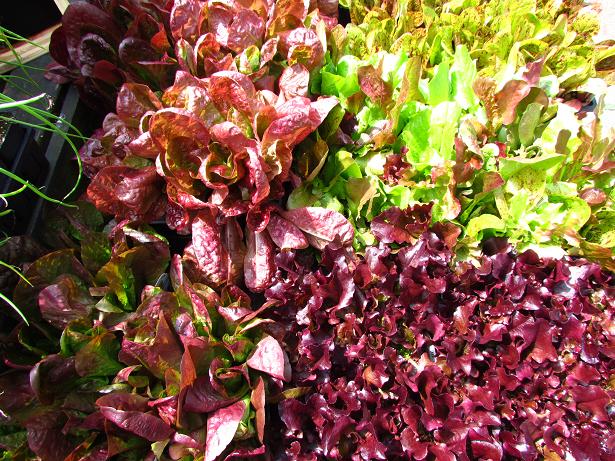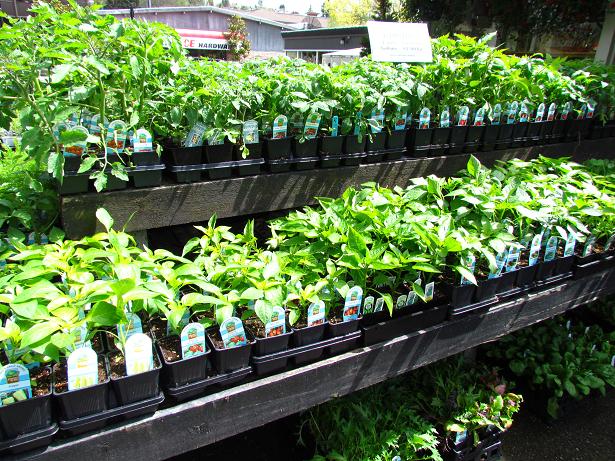
Seattle's coolest little garden center with perennials, shrubs, trees, containers or pottery for creating great gardens or planted containers
About Garden Center and Gift Shop
3213 West Smith
and around the corner
our new Gift Shop at
2455 32nd Ave West
Seattle, WA 98199
Mon-Fri 9:30am- 6:00pm
Sat 9:00am- 6:00pm
Sun 10:00am- 5:00pm
Tel: (206) 284-1161
Fax: (206) 284-0081
Email
MasterCard, Visa
Vegetables and Herbs

Plant now for a full harvest of tasty vegetables
New veggie starts are available for your organic
garden. It is time to plant lots of vegetables for your organically grown
leafy greens (spinach, lettuce, romaine, kale, chard, and others), tomatoes,
peppers, broccoli,
beets, arugula and much more.
Vegetables and Your Health
It has been known for many years that eating fresh vegetables and fruits can be very beneficial to your health by providing lots of necessary vitamins and nutrients to your body. The latest research is now showing that even beyond that, fresh grown plant based food can also provide you with a diverse mix of beneficial bacteria that promotes a healthy digestive system and helps your body fight off disease by strengthening your immune system.
Most individuals have over 600 types of bacteria in their digestive system that help the body breakdown food and, further, help signal the body to produce immune responses to harmful organisms that may be present. Many of these bacteria help to breakdown some of the nutrients that our bodies can't digest on its own. Our bodies need regular replenishment of many of these bacteria and consuming fresh foods like the kind you can grow in your garden can aid in this process.
Vegetables for Planting
Great eating begins with great ingredients and we have what it takes to help you grow the best of all you can in this wonderfully productive climate. From our home garden as well as our P-Patch, we harvest many things including great tasting lettuces and romaine along with Walla Walla sweet onions. Last year we picked peas from late April through June, and in late July we started getting the real prize: fresh tasty tomatoes. The first of our tomatoes were planted in early April with the help of the Season Extender (aka Wall-of-Water), and those plants were the first to produce ripe fruit. The 10 tomato plants we had at the P Patch probably produced between 35 to 40 pounds of ripe fruit last year! This provided us with lots of frozen tomato sauce filling up our freezer to eat until the next harvest. As usual, we had more of the very sweet Sun Gold cherry tomatoes than we could eat ourselves - so we had lots to share with lucky customers here at the store!
Don't forget to Fertilize - organically!
Its been estimated that food crop yields increase by between 40 to 60% by the judicious use of fertilizers! I always find it amazing how some people will go to the trouble to carefully prepare, design and plant a veggie garden and then fail to take one step that will give them bigger, healthier plants and a much larger harvest. Using the proper organic fertilizer and adding other things like lime can not only give you more yield but may save your crop from suffering a failure when a disease or insect problem occurs.
Start by mixing into your soil a great organic compost (like our Gardener and Bloome Harvest Supreme - it contains 15% chicken manure, bat guano, worm castings and other good stuff for your vegetable growing needs) to provide the best foundation for the plants to grow in. Then add some Dr. Earth or EB Stone Tomato Vegetable fertilizer for a great harvest. If you are planting tomatoes or peppers, take the time to add a little dolomite lime as well. It provides extra calcium to help prevent blossom-end rot that may show up just when your fruit should be ripening
During the growing season you may want to add a good liquid fertilizer specifically designed for food crops like Gardner and Bloome liquid organic concentrate or Alaska Fish Feritlizer. If you have any questions, nearly all of our friendly staff grow their own food crops and can give you great advice when needed.
Partial list of 2015 Vegetables (as available):
Artichoke - Imperial Star
Arugula
Beans - Blue Lake Pole, Royal Burgandy Bush
Beets - Golden, Red, Detroit Red, Chioggia, Shiraz Tall Top
Cauliflower - Snowball, Cheddar
Celery - Tango
Chard - Swiss
Collards - Champion
Corn - Jubilee
Cucumber - Marketmore
Eggplant - Imperial Black Beauty
Kale - Red Russian, Dinosaur
Kohlrabi - Kolibri
Lettuce - Allstar Gourmet Mix, Buttercrunch, Freckles, Marvel of Four Seasons, Mottistone, Pic 714, Red Romaine, Red Sails, Rouge D'Hiver, Salad Greens, Spicy Mesclun Mix.
Peppers - King of the North (the best bell-type for Seattle), jalepeno, Gypsy, Sorento, Habenero, California Wonder, Charleston Hot, North Star.
Pumpkin - Baby Pam
Squash - Acorn, Delicata, Yellow Crookneck, Yellow Scallopini, Zucchini.
Tomatoes - See list
Tomatillos
Zucchini - Black Beauty
Italicized veggies coming soon.
All About Tomatoes - Click here for information on all of our Tomato varieties.
Herbs
You can find lots of herbs for planting out in the herb garden or even for growing indoors for kitchen harvest use. In season we carry basil, chives, cilantro/coriander, fennel, mints, parsley, oregano, sage, savory, stevia, thymes, lemon verbena, tarragon and even bay. These are all grown organically to be used in cooking so you can feel safe in their quality.
Mint: one of the most useful herbs known to man, menthol (and carvone in the case of the spearmints) is probably used by all human cultures for a wide variety of purposes. Some of the more obvious include teas, flavorings (toothpaste, mouthwash, etc.), and ointments, but many also like to enjoy the flavor in cooling beverages. One of the most popular of late is the Mojito. These drinks call for spearmint leaves. Some recommend the use of a particular spearmint: Kentucky Colonel Mint - a hybrid between apple mint and spearmint that was bred specifically for another drink, the Mint Julep!
Home Grown Mojitos
Summer is the time to harvest some of that mint you are growing in the herb garden and make some great tasting Mojitos. In case you haven't got any mint going yet we've got lots of it ready to plant. And in case you don't know how to make mojitos here are a few recipes to get you started: 1.) Traditional Mojito 2.) The Best Ever (traditional version) 3.) The Best Ever (with some added twists) 4.) Dos and Don'ts
Partial list of 2013 Herbs:
Basil - Genovese, Red Rubin, Sweet & Thai
Catnip
Chamomile - German
Cilantro
Chervil
Chives
Dill
Fennel - Sweet Fennel
French Sorrel
Lavender - Anouk, Fat Spike, Fred Boutin & Hidcote
Lemongrass
Lemon Balm
Lemon Verbena
Mint - Peppermint, Spearmint, Strawberry Mint
Oregano - Greek, Hopley's Purple Oregano, Italian
Parsley - Curly & flat leaf
Rosemary - Arp, Creeping & Tuscan Blue
Sage - Berggarten, Golden Leaf, Pineapple, Purple & Tricolor
Stevia
Tarragon - French
Thyme - English, Lime
Free Burlap for P-Patch Users
Currently out of stock.
Magnolia Garden Center currently has burlap bags previously used for coffee or chocolate beans. These make a good mulch for the winter garden that is lying fallow. If you could use some in your P-Patch please come by with your P-Patch card and we'll see that you get some burlap!
